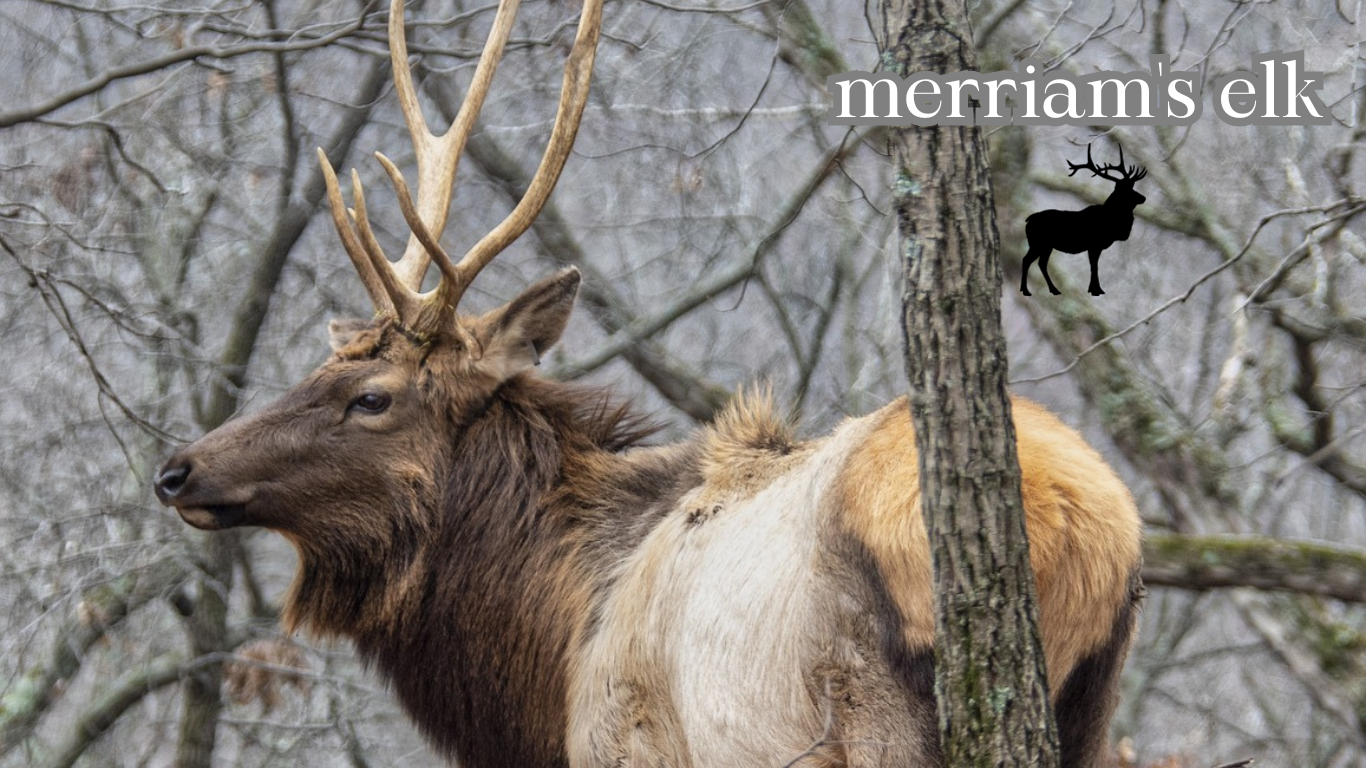Numerous magnificent species can be found in North America, including the elk. Merriam’s elk is one of the rarest and most fascinating subspecies of elk in the Cervidae family. Merriam’s elk (Cervus canadensis merriami), named for renowned American biologist Clinton Hart Merriam, has unique traits and inhabits particular areas, adding to North America’s abundant variety.
Physical attributes:
Like other elk subspecies, Merriam’s elk is a striking animal. Adult females, referred to as cows, are usually smaller, weighing between 500 and 600 pounds, while adult males, known as bulls, often weigh between 600 and 1,000 pounds. Merriam’s elk is distinguished by its broad, sweeping antlers, which may reach a width of four feet. During the rutting season, these antlers are essential for drawing potential mates and establishing dominance within the herd.
Dispersal and Environment:
Merriam’s elk are found mainly in western Canada and the United States mountainous areas. Their range encompasses sections of Mexico, Arizona, New Mexico, and the Rocky Mountains. Elk are adaptable to various terrains by being well-suited to multiple habitats, such as scrublands, alpine meadows, and coniferous forests.
Social Structure and Behaviour:
These elk are gregarious creatures congregating in herds, particularly in the off-breeding season. Dominant bulls lead the pack in a hierarchical social structure. Bulls participate in remarkable power demonstrations and vocalizations to establish mating dominance during the autumn rutting season. During the mating ritual, they bugle—a unique vocalization reverberating throughout the mountains—to challenge other males and announce their presence.
Status of Conservation:
Although the number of elk in North America is mainly steady, Merriam’s elk are threatened by habitat loss, fragmentation, and conflicts between people and other species. Conservation efforts—including habitat protection and sustainable management practices—are essential to ensure the long-term survival of this subspecies.
The significance of ecology
Merriam’s elk are essential to the ecology in which they live. They support the balance and well-being of plant communities by grazing, browsing, and seed distribution. They also assist other animal species by influencing predator-prey dynamics
Frequently Asked Questions about Merriam’s Elk
1. What distinguishes Merriam’s elk from other subspecies of elk?
Cervus canadensis merriami, the formal name for Merriam’s elk, is a unique subspecies distinguished by its distribution and preferred habitat. They can be distinguished from other elk subspecies that may live in different geographic regions by their predominant distribution in the mountainous areas of the western United States and southern Canada.
2. How big do the elk grow in Merriam?
Adult females, referred to as cows, are usually smaller, weighing between 500 and 600 pounds, while adult males, known as bulls, often weigh between 600 and 1,000 pounds. Their remarkable stature is partly attributed to the size and form of their antlers, particularly in males.
3. Why does the bugling sound occur during the rutting season?
During the rutting season, male elk make a characteristic vocalization known as “bugling” to indicate their authority and presence. Bulls use it to challenge other males, establish dominance within the herd, and communicate with females. During this mating rite, the distinctive sound of the bugle reverberates through the highlands.
4. Where in the wild may one find Merriam’s elk?
The Rocky Mountains and areas from Arizona and New Mexico to southwest Canada are home to Merriam’s elk. They may flourish in various settings, including scrublands, alpine meadows, and coniferous forests, because of their adaptability.
5. How far along is Merriam’s elk conservation?
Merriam’s elk are threatened by habitat loss, fragmentation, and conflicts between people and other species, even though the elk population in North America is comparatively steady. Conservation initiatives—including habitat preservation and sustainable management techniques—are essential to ensure their long-term survival.
6. What is the ecological contribution of Merriam’s elk?
Merriam’s elk engages in crucial ecological functions such as browsing, grazing, and seed distribution. Their existence benefits other animal species that share their habitat by influencing predator-prey interactions and maintaining the health and balance of plant ecosystems.
7. Are there any particular difficulties facing Merriam’s elk conservation?
Indeed, there are difficulties such as habitat degradation brought on by human development, range fragmentation, and possible confrontations with human activity. The primary goal of conservation activities is to solve these issues to guarantee the elk populations in Merriam remain healthy.
8. In what ways may people help preserve Merriam’s elk?”
By supporting animal conservation organizations, participating in habitat restoration initiatives, and advocating for appropriate land-use practices, anyone can help preserve Merriam’s elk. Furthermore, to ensure natural ecosystems’ long-term survival, awareness about their significance must be raised. That coexist in their habitat.
In summary:
The unusual features and significant ecological importance of Merriam’s elk serve as a testament to the robust and diverse wildlife that may be found in North America. To ensure the continued survival of this exquisite subspecies and provide future generations with the opportunity to see the elegance and beauty of Merriam’s elk in the wild, conservation initiatives and a fuller understanding of their behavior and habitat requirements are essential.
